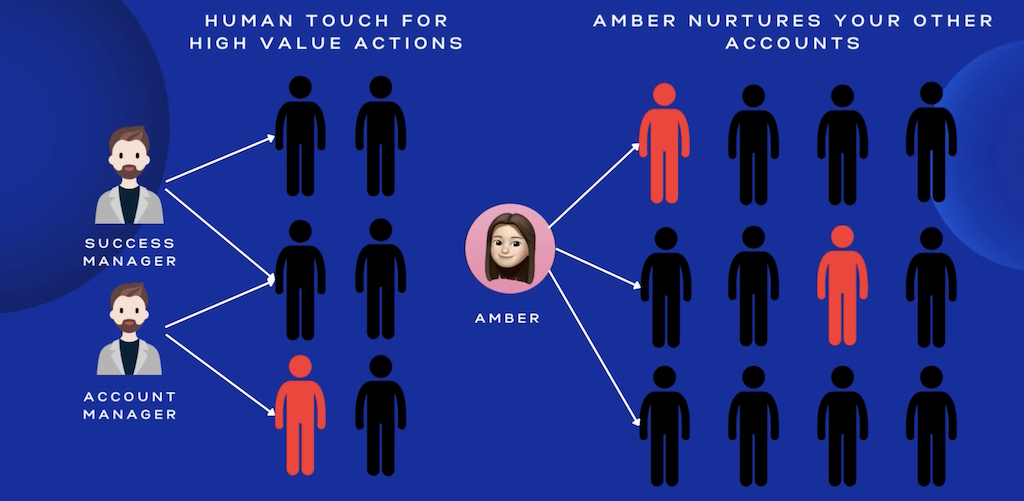
About
Amber AI helps increase revenue for B2B companies selling their products and services to SMB customers and no, they don’t help B2B sellers find new customers. Their goal is to increase NRR (Net Revenue Retention), sometimes called NDR (Net Dollar Retention), to retain and increase the revenue a company’s existing customers can generate.
The problem is that B2B companies selling to SMBs have a problem – for a live salesperson to break even, they must make $2 million worth of sales. But SMBs can only make small to medium-sized orders and as a result, salespeople are forced to hang on to a 100-1000 customers.

However, a salesperson cannot effectively work with such a large number of customers, squeezing out of each one a reason and an opportunity to make a new order or increase the size of the current order. Amber AI helps salespeople divide all their customers into two groups: The first group is customers who are capable of ordering more.

The second group is all the others, which can be handled not by a live person but by the Amber AI assistant. The AI assistant maintains a list of all the company’s customers on the platform, considering all their orders, actions, and results of previous contacts. Here, the AI assistant automatically updates the list of the most profitable customers the salesperson needs to personally work with.
The AI Assistant draws information for the customer prioritization algorithm from all sources connected to Amber AI – CRM (Salesforce, HubSpot), customer communication platforms (Zendesk), data aggregators (Snowflake), and others.

Dividing customers into “profitable” and “the rest” does not mean that the salesperson forgets about the “rest” – it’s just that the Amber AI assistant works with them instead of a live salesperson. The trick is that the AI assistant’s task is the same – to increase revenue from the client. For this purpose, the AI assistant tries to build “personal” relationships with customers, regularly “pokes them with a stick” for interest in new products or promotions, and also tries to sell them something when they receive a new order.

If the AI assistant suddenly detects a decent-sized interest in a customer, it automatically reprioritizes that customer and hands them over to a live salesperson for further processing. If the AI assistant sees no opportunities to earn more money from the customer, it will continue to work with them independently.
Amber AI is currently undergoing Y Combinator, from which it received the required $500,000 in investment. Interestingly, the Y Combinator website states that the startup was founded in 2024, meaning it was formed as a company after being accepted to Y Combinator.
What’s interesting
NRR (Net Revenue Retention), the increase in revenue per customer, is the most critical growth driver for any business.
The problem is that increasing NRR is more accessible when a business works with large customers. Then, each salesperson has only a few such clients—each of whom he can work with individually, taking advantage of any opportunities to earn more money from them.

Unfortunately, there are no such opportunities for individual work when working with many small clients. Therefore, an NRR of 110% is considered very good for companies working with small and medium-sized businesses. At the same time, companies working with large clients have an excellent NRR of 150%.

A startup called Catalog solves the problem of processing incoming orders from these companies. Using the platform, one of their first customers reduced the average processing time per order from 10 to 2 minutes. This French startup raised its first investment of 3 million euros. So, startups dedicated to improving the efficiency of B2B companies selling their products and services to small and medium-sized businesses are starting to attract investor interest.

A startup called Resonance from the same current set of Y Combinator that has also made a platform to increase NRR (Net Revenue Retention). However, their startup’s audience is cloud service developers. The platform aims to effectively notify users about new and existing features of these services they are not already using.
Users may want to use them—and start paying extra money for them or upgrading to the next plan that includes these features, thus bringing more money to the developer. At least the second service dedicated to increasing NRR in one Y Combinator suite confirms the interest and promise of this topic.

Where to go
Two possible movement directions emerge from today’s review. The first direction is to create platforms to increase the efficiency of B2B companies selling to small and medium-sized businesses. Efficiency gains can come from a) saving time working with customers (like Catalog) or b) increasing profits from existing customers (like Amber AI). Clearly, you can find other places to save time and other ways to increase customer profits and there is still room for search and imagination.

The second direction is to create platforms that help increase NRR (profits from the customer) for sellers from different spheres and developers of other products. The beauty of this direction is that it can be done without the dauntless task of finding new customers and users. If a company can’t find new customers on its own, there’s a good chance that it will die soon – because they either have a bullshit product or a bullshit sales system.

But a company with a good product and good sales that has gained a bunch of customers but can’t handle them properly – that’s a typical situation. What kind of companies are these? What exactly can’t they handle? How can they be helped with this? So, which way do we go – will we increase the effectiveness of B2B salespeople or help someone increase NRR? Or do we decide to combine these tasks by creating an analog of today’s Amber AI?
About
Website: helloamber.ai
Last round: $500K, 01.02.2024
Total investment: $500K, rounds: 1
